This article first appeared in Sidecar Traveller Nr.46 October 2019

I recently spent a couple days helping a friend swap his sidecar from a BMW G650 GS to a F800 GS.
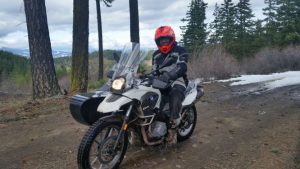 The 650 was his first sidecar rig; he’d gotten a smoking deal on it and it had served its purpose well, but Wrayal is a lanky Texican; the 650 was just too small for comfort. His other ride is a BMW F800GS. Taller and more powerful, the 800 is just a better fit. He liked the sidecar, a nice DMC M72, so the obvious solution was to swap it to the bigger bike.
The 650 was his first sidecar rig; he’d gotten a smoking deal on it and it had served its purpose well, but Wrayal is a lanky Texican; the 650 was just too small for comfort. His other ride is a BMW F800GS. Taller and more powerful, the 800 is just a better fit. He liked the sidecar, a nice DMC M72, so the obvious solution was to swap it to the bigger bike.
It looked like a pretty straightforward project, and for the most part it was. The thing is, every sidecar installation seems to be a one-off, custom build, and this one was no exception.
Wrayal ordered a mounting kit for his 800 from DMC Sidecars. It took two or three weeks to fabricate the parts and ship them to my house. Wrayal brought the bikes over and we gleefully opened the boxes, pawing through the bubble wrap and pulling out the black, powder-coated pieces of steel which made up the subframe.
 We held the parts up to the bike and tried to visualize how they would fit. Our joy turned to disappointment when we discovered the subframe was meant for a left-hand mounted sidecar. Unless Wrayal wanted to move to Australia, this wouldn’t do at all.
We held the parts up to the bike and tried to visualize how they would fit. Our joy turned to disappointment when we discovered the subframe was meant for a left-hand mounted sidecar. Unless Wrayal wanted to move to Australia, this wouldn’t do at all.
Mistakes happen. Wrayal didn’t let it ruin his day. DMC was closed for the weekend, but we called and left messages, relating the problem. Jay Giese, the owner, personally called back and apologized for the mistake. It would take a couple of weeks to make a new subframe and get it powder-coated.
Jay offered to have the shop do the install, free of charge, if Wrayal could bring the bike and the sidecar in. This is really DMC’s preferred method of installation, and it makes a lot of sense. If your bike is in their shop, they have all the parts at hand and can tweak things to fit the small variations that every bike has and which can make fitting custom parts a frustrating experience. We probably should have taken him up on his offer, but decided to go ahead and do it ourselves. We thanked Jay and asked him to ship the parts when they were ready.
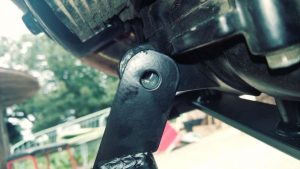
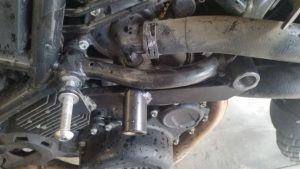 I think there may have still been some confusion about which bike Wrayal was installing the subframe on, because when the new parts arrived, they nearly fit, but not quite. The tabs on the bottom mounts fouled the engine case and the bolt holes were just enough out of alignment that they wouldn’t line up. The top front mount was up against a frame tube and the front bolt hole didn’t seat. The rear mount looked like it might fit, but we had to pull the swingarm pivot spindle before we would know for sure. Most of the bolts that came with the kit didn’t fit Wrayal’s bike, so we had to make a couple of trips to the hardware store.
I think there may have still been some confusion about which bike Wrayal was installing the subframe on, because when the new parts arrived, they nearly fit, but not quite. The tabs on the bottom mounts fouled the engine case and the bolt holes were just enough out of alignment that they wouldn’t line up. The top front mount was up against a frame tube and the front bolt hole didn’t seat. The rear mount looked like it might fit, but we had to pull the swingarm pivot spindle before we would know for sure. Most of the bolts that came with the kit didn’t fit Wrayal’s bike, so we had to make a couple of trips to the hardware store.
Wrayal called DMC for clarification. Jay and his shop manager, Andrew Stringfield, offered some suggestions. Andrew felt the fitment issues were due to variations in BMW’s assembly tolerances. He said occasionally it was necessary to loosen the motor mounts to get the holes to line up and tighten things back up evenly after the subframe had been installed; sometimes a little grinding was needed to get the tabs to fit. Once again, we were encouraged to bring the bike in for installation. We decided to carry on ourselves, after being assured they would make it right if we modified the parts and still couldn’t get them to fit.
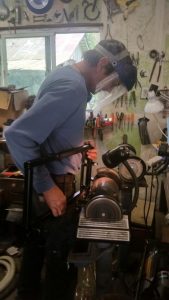 We ended up grinding about a quarter-inch off the mounting tabs and filing out the bolt holes just a smidge. With those modifications the bottom subframe bolted up to provide a rock-solid mount.
We ended up grinding about a quarter-inch off the mounting tabs and filing out the bolt holes just a smidge. With those modifications the bottom subframe bolted up to provide a rock-solid mount.
We had to build a spacer and carve some metal from the top of the upper front mount to get it to fit properly. Again, with just a little fussing, it did bolt on with no slop or play.
The rear mount was the most intimidating, but, following Jay’s instructions, it proved the easiest of the three pieces to install. We drifted out the swingarm spindle and installed it the other way ‘round, threaded into the mount to secure it in place. Another bolt into the frame and a plate clamped around the passenger foot peg hanger and the rear mount was done.
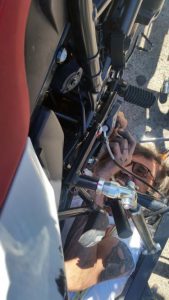 We bolted up the sidecar brake assembly and attached it to the rear brake lever. The hose for the master cylinder was too short to reach the mounting tab, so we zip-tied the master cylinder to the bike frame until Wrayal can get a longer brake line.
We bolted up the sidecar brake assembly and attached it to the rear brake lever. The hose for the master cylinder was too short to reach the mounting tab, so we zip-tied the master cylinder to the bike frame until Wrayal can get a longer brake line.
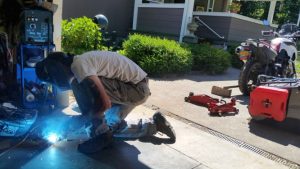 With the subframe installed we just had to pull the sidecar off the 650 and bolt it to the newly installed subframe on the 800. This went relatively smoothly. We had cheaped out and didn’t buy new struts, hoping to be able to use the struts from the 650. This almost worked. The front strut just fit but there was no room for more adjustment. It may need to be replaced later. The rear strut was too short. We ended up cutting up and welding a replacement, using a spare strut I had in my parts bin.
With the subframe installed we just had to pull the sidecar off the 650 and bolt it to the newly installed subframe on the 800. This went relatively smoothly. We had cheaped out and didn’t buy new struts, hoping to be able to use the struts from the 650. This almost worked. The front strut just fit but there was no room for more adjustment. It may need to be replaced later. The rear strut was too short. We ended up cutting up and welding a replacement, using a spare strut I had in my parts bin.
 It took about an hour of fussing to dial in the alignment. We ended up with twelve inches of sidecar lead, just under an inch of toe-in, and about an inch of lean-out (measured from the handlebar tips to the ground).
It took about an hour of fussing to dial in the alignment. We ended up with twelve inches of sidecar lead, just under an inch of toe-in, and about an inch of lean-out (measured from the handlebar tips to the ground).
Wrayal’s test ride was successful. He is going to ride it a while as it is, but thinks he may need to reduce the lean-out a little bit.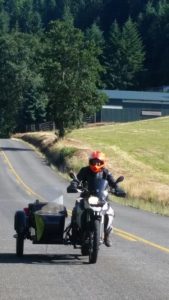
I rode in the sidecar for several miles. I have always liked DMC’s M72 models. The fiberglass is first-rate and the sidecar is comfortable and quiet. And I was very impressed with the mounts. Even though we did have to do a little modification to get a proper fit, the DMC mounting system is well designed. It is solid, with no slop, no sign of flex, no movement at all. I think Wrayal will get many miles of happy riding with his new rig.





0 Comments